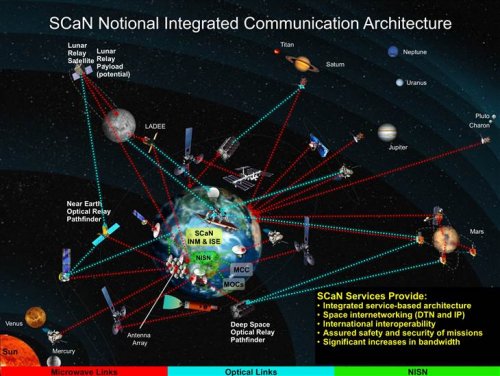- Joined
- 9 October 2009
- Messages
- 21,969
- Reaction score
- 13,615
Architecture.
http://www.popsci.com/technology/article/2013-03/nasa-wants-options-space-internet
https://www.fbo.gov/?s=opportunity&mode=form&id=f4b917baa5031642eda81a268331add4&tab=core&_cview=0
Extract from RFI:
http://www.popsci.com/technology/article/2013-03/nasa-wants-options-space-internet
https://www.fbo.gov/?s=opportunity&mode=form&id=f4b917baa5031642eda81a268331add4&tab=core&_cview=0
Extract from RFI:
Solicitation Number: Notice Type:
SBRSFYI1301 Sources Sought
Synopsis:
Added: Mar 07, 2013 5:49 pm
The National Aeronautics and Space Administration (NASA) is soliciting information through this Request for Information (RFI) in support of the Goddard Space Flight Centers (GSFC) Space-Based Relay Architecture Study. The GSFC is responsible for providing the Agencys communications and navigation services for space flight missions in the vicinity of the Earth. These services are considered a national asset, serving the NASA science and human spaceflight community, other government agencies, and international partners. The Space Communications and Navigation (SCaN) Program provides user missions with communication services that may include transmitting data and/or commands to and from user mission platforms (such as crewed and/or uncrewed space vehicles); deriving information from transmitted signals for tracking, position determination, and timing; and measuring the Radio Frequency (RF) emission or reflection from celestial bodies. Currently, the GSFC manages the Space Network (SN) Element, comprised of the Tracking and Data Relay Satellite System (TDRSS) and associated ground stations. The GSFC also manages the Near Earth Network (NEN). The SN is a unique, world-class satellite communications system, which relays command, telemetry, tracking and science data at S-, Ku-, and Ka-Band frequencies to and from customers. TDRSS customers include Low Earth Orbiting (LEO) scientific satellites, the International Space Station (ISS) and its servicing fleet, scientific aircraft and balloons and expendable launch vehicles. The SN consists of a constellation of seven TDRS geosynchronous satellites and associated ground systems and operates essentially as a bent pipe relay system between civilian customer platforms and ground facilities (global coverage and low latency support). While the SCaN Program is in the process of launching three new third generation TDRSS satellites (K/L/M), by the end of this decade the remaining on-orbit satellites are aging and expected to be retired within the next decade or so. Most of these satellites have exceeded their design life. With constellation capacity projected to fall below aggregate mission demand by the early 2020s, there is an emerging need to initiate planning for a future communication architecture. The GSFC is leading a study for the SCaN Program to address the architecture for the development of the next generation architecture for civilian space communications and navigation, which may include both space-and ground-based assets. The capability of the future architecture must be driven by user needs and stakeholder interests. It shall also take into consideration a measure of backward compatibility with the current TDRSS, assuming there will be a subset of customers moving to the new relay system. It shall also consider future science missions with greatly increased sensitivity of sensors that are capable of large data captures as well as future missions to the Moon and Mars where surface activities require supporting communications. The cost value proposition of the future architecture must be an integral part of its design. Ownership and operations options will be evaluated including governmentowned, commercially owned, and mixtures. The future architecture must be flexible to meet dynamically changing needs between investments in operations (e.g. to lower cost) and development (i.e. to infuse technologies). Another goal would be to have the architecture interoperable with communication systems operated by other civilian government agencies, international space agencies, and potential commercial service providers as well as with the NEN and DSN. The resultant architecture must be affordable as well as sustainable within a flat or decreasing budget environment. The architecture must be extensible to address new requirements from traditional (e.g. higher data rate or ultra-precise orbit determination missions) and non-traditional markets (e.g. human deep space missions). The resultant architecture should take into consideration the need for security and be protective of these national assets and impervious to system breach. Responders should make assumptions about user needs and data volumes for the 2022 and beyond timeframes based on representative science missions and extensions. These objectives should not limit consideration of non-traditional concepts, models and/or designs. Under the direction of the SCaN organization located within the Human Exploration and Operations Mission Directorate (HEOMD), NASA Goddard Space Flight Center has been tasked to analyze the trade space and define the top level framework for the next generation Space Based Relay Architecture. Alternative solutions that may cross current boundaries with respect to services acquired from non-traditional partners will not be excluded. Instructions for Responses NOTE: This is not a request for proposal, quotation, or invitation for bid notice and is intended for information and planning purposes only. NASA does not intend to award a contract on the basis of this RFI. However, NASA may consider issuing formal solicitations at a later date. NASA is also seeking capabilities from all categories of Small Businesses for the purpose of determining the appropriate level of competition and/or Small Business subcontracting goals for this requirement. No solicitation exists; therefore, do not request a copy of the solicitation. If a solicitation is released it will be synopsized in FedBizOpps and on the NASA Acquisition Internet Service.

